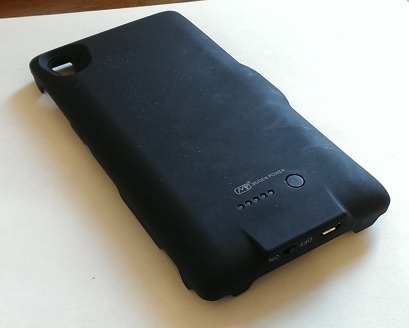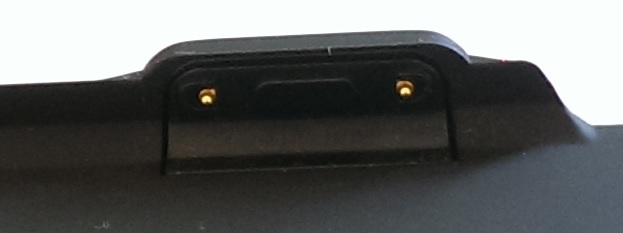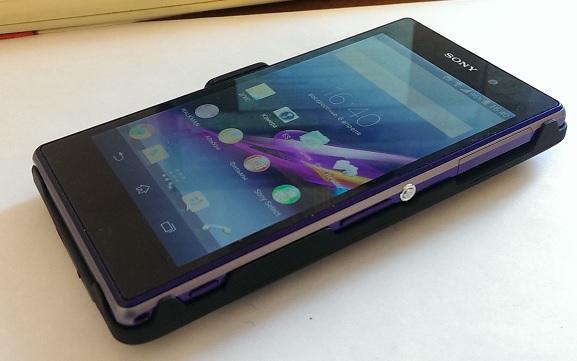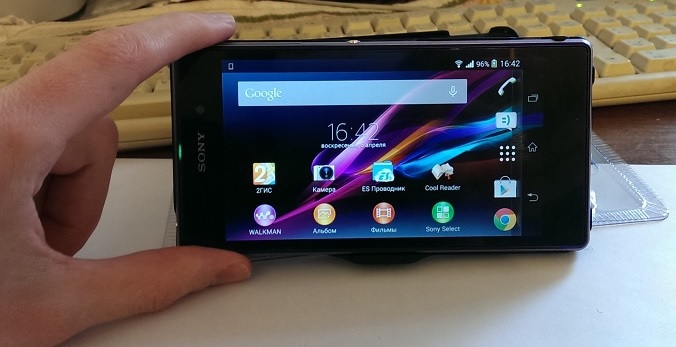3000 mAh Battery Cover for Sony Xperia Z1 Review
Compact external battery case for a non-compact smartphone. We study fresh product from Mugen Power .
Sony Z1 was released in September 2013 and is currently the flagship of the line of Sony-based Android devices. Yes, the Z2 was introduced at the MWC 2014, but it has not yet been marketed, so the “best from Sony” is exactly the Z1. I purchased this machine in January of this year, and the New Year promotion with a big discount contributed to this in no small degree. I like the smartphone as a whole, I also paid attention to the unique possibility of Sony devices - charging through a special magnetic connector on the case, bypassing the standard USB, which is also covered with a water plug. This gave hope that manufacturers of external batteries use it, dispensing with not very elegant "tails on a string." An example of such an extremely unpractical method of charging: HTC One, a review of the battery for which I have already done: habrahabr.ru/post/206408 In the future I will refer to this review. Immediately, I note that the battery case for Z1 from Mugen Power uses exactly the magnetic connector for recharging.
The first news about the new product appeared around January, when the design was completed. At the end of February, the cover began to be sent to everyone. Unfortunately, due to the new rules for postal items and online purchases, my battery was sent only at the end of March. Last time, delivery was handled by Federal Express, this time I was not aware of CDEC (http://cdek.ru/). However, the time of travel companies are the same.
The page on the online store website:
mugen.co/sony-ericsson/sony-xperia-z1/mugen-power-3000mah-battery-case-for-sony-xperia-z1-docomo-xperia-z1-so-01f.html
The cost at the time of publication of the article was $ 89.50, excluding delivery. And delivery is a very expensive service, it is worth considering this when placing an order.

The kit is traditional for Mugen Power: a plastic transparent box of two halves with instructions and a battery. It is worth noting, this time the halves were fastened with strong adhesive tape with the inscription "QC PASS". You can open them without damage, but it is extremely difficult (I did not succeed). In general, it’s a trifle, but it's nice - I think it’s not me alone that I like to receive a device that only the manufacturer had in their hands before me. There is no charger.

')

The battery has a capacity of 3000 mAh. Given the large area of the back surface, a relatively small (for an external battery) capacity gave a small thickness of the case, comparable to the thickness of the smartphone itself.
The case is made of soft-touch plastic, very nice to the touch, in black. For a short time of operation (a week with a little), the coverage has not gone anywhere. The case for HTC One uses the same material, and there for three months the surface is like new. I think with this model you can also count on the long-term preservation of a presentable appearance. For example, trips on the floor (the device in the case lies at night near the bed, and in the morning, regaining consciousness, you can kick off the structure to the other end of the room) had no effect on the appearance.
Along the perimeter of the cover are the bumpers that fix the installed smartphone. On the inner surface - the parameters of the battery and instructions on how to install the smartphone. The platform for connecting to the magnetic connector Z1 is thicker than other sides, it looks quite reliable.

On the outside of the case you can see the logo of the manufacturer. Below it is a group of five diodes and a button to indicate the remaining charge (pressing causes an indication for 3 seconds). The left 4 diodes are blue and display the charge level, the right red light is on when charging the case (10 years ago this phrase would have surprised me and even laughter).

The bottom of the case contains a USB connector for charging the case and a two-way switch. It serves to enable and disable the charging of the smartphone installed in the cover. The switch does not dangle, spontaneously does not change the position (for example, in your pocket). USB connector is very tight, for the first time barely plugged in the cable. After that is easier. On the other hand, the cable itself will not fall out of the case.
A pair of pictures of the hero of the review next to the case for the HTC One


To install the smartphone, it should be inserted into the magnetic connector of the cover, then attach it back to the cover.
The smartphone is fixed protruding sides of the cover only due to the force of friction. The device from the case, of course, does not fall out. But it’s quite simple to get it out of there, the HTC One in its case sat much stronger. These sides leave open all slots (sim, micro-sd, usb) and buttons of the device. This, of course, is convenient with frequent use of these connectors, but reduces the area of contact of the device with the case, reducing the force of fixation of the device in the case.

The assembly that has learned the assembly surprisingly does not seem cumbersome or inconvenient. Due to the small thickness of the case, it is perceived as a normal case, without a built-in battery. Of course, he cannot provide protection against falls, but it became more convenient for me personally to hold a large apparatus in my hands. First of all, due to the material of the cover and its smoothly curved sides. The weight of the case is two times less than the smartphone itself. If you take in one hand Z1, in another case, then the weight of the second simply will not be felt compared to a smartphone.

The smartphone perceives the case as a native docking station. It becomes possible to change the orientation of the desktop. It is important to note that in this mode, outgoing and incoming calls will initially go through the external speaker, in the “speakerphone” mode. This is a feature of software from Sony when in the docking station.
The results are as follows:
Charging current: 700 mA at the beginning, gradually decreasing to 350 at the end of the charge.
Charge rate: about 25 percent per hour.
Charge efficiency: by morning, the battery of the case was completely discharged, the smartphone was fully charged and was already discharged, although the power from the case was not turned off.
This experiment was repeated 3 times and with a large initial discharge of the smartphone, the results were the same, the differences within the margin of error.
The cover from the 1A power adapter is fully charged for about 4 hours (before the red charge indicator turns off). At the same time, you can charge the case and smartphone.

I frankly liked the battery case. He does not disfigure (in my opinion) a beautiful smartphone, lies comfortably in his hand, adds only a little weight, provides an increase in the operating time of the smartphone more than one and a half times. An external switch allows you to control the charge without manipulating the cables, and the use of a magnetic connector eliminates the need for external cords and connectors that are so easily broken off during active use.
You can only ask for the lack of a cover with a larger battery. Given the size of the smartphone, I think it would be possible to place 6000 mA without a strong increase in thickness. And with such a width-height a large thickness would not be so noticeable.
PS All pictures were taken on the HTC One with manual settings. As it turned out, the macro in low light turns out to be surprisingly decent. About the case it is worth adding that the option for HTC One after several charge-discharge cycles for a month began to give giving a little more. With the hero of the review will almost certainly be the same situation. Not to say that much more, the difference is obvious.
Dust soft-touch coating collects quickly ..
Sony Z1 was released in September 2013 and is currently the flagship of the line of Sony-based Android devices. Yes, the Z2 was introduced at the MWC 2014, but it has not yet been marketed, so the “best from Sony” is exactly the Z1. I purchased this machine in January of this year, and the New Year promotion with a big discount contributed to this in no small degree. I like the smartphone as a whole, I also paid attention to the unique possibility of Sony devices - charging through a special magnetic connector on the case, bypassing the standard USB, which is also covered with a water plug. This gave hope that manufacturers of external batteries use it, dispensing with not very elegant "tails on a string." An example of such an extremely unpractical method of charging: HTC One, a review of the battery for which I have already done: habrahabr.ru/post/206408 In the future I will refer to this review. Immediately, I note that the battery case for Z1 from Mugen Power uses exactly the magnetic connector for recharging.
The first news about the new product appeared around January, when the design was completed. At the end of February, the cover began to be sent to everyone. Unfortunately, due to the new rules for postal items and online purchases, my battery was sent only at the end of March. Last time, delivery was handled by Federal Express, this time I was not aware of CDEC (http://cdek.ru/). However, the time of travel companies are the same.
The page on the online store website:
mugen.co/sony-ericsson/sony-xperia-z1/mugen-power-3000mah-battery-case-for-sony-xperia-z1-docomo-xperia-z1-so-01f.html
The cost at the time of publication of the article was $ 89.50, excluding delivery. And delivery is a very expensive service, it is worth considering this when placing an order.
Contents of delivery

The kit is traditional for Mugen Power: a plastic transparent box of two halves with instructions and a battery. It is worth noting, this time the halves were fastened with strong adhesive tape with the inscription "QC PASS". You can open them without damage, but it is extremely difficult (I did not succeed). In general, it’s a trifle, but it's nice - I think it’s not me alone that I like to receive a device that only the manufacturer had in their hands before me. There is no charger.
Battery Case

')

The battery has a capacity of 3000 mAh. Given the large area of the back surface, a relatively small (for an external battery) capacity gave a small thickness of the case, comparable to the thickness of the smartphone itself.
The case is made of soft-touch plastic, very nice to the touch, in black. For a short time of operation (a week with a little), the coverage has not gone anywhere. The case for HTC One uses the same material, and there for three months the surface is like new. I think with this model you can also count on the long-term preservation of a presentable appearance. For example, trips on the floor (the device in the case lies at night near the bed, and in the morning, regaining consciousness, you can kick off the structure to the other end of the room) had no effect on the appearance.
Along the perimeter of the cover are the bumpers that fix the installed smartphone. On the inner surface - the parameters of the battery and instructions on how to install the smartphone. The platform for connecting to the magnetic connector Z1 is thicker than other sides, it looks quite reliable.

On the outside of the case you can see the logo of the manufacturer. Below it is a group of five diodes and a button to indicate the remaining charge (pressing causes an indication for 3 seconds). The left 4 diodes are blue and display the charge level, the right red light is on when charging the case (10 years ago this phrase would have surprised me and even laughter).

The bottom of the case contains a USB connector for charging the case and a two-way switch. It serves to enable and disable the charging of the smartphone installed in the cover. The switch does not dangle, spontaneously does not change the position (for example, in your pocket). USB connector is very tight, for the first time barely plugged in the cable. After that is easier. On the other hand, the cable itself will not fall out of the case.
A pair of pictures of the hero of the review next to the case for the HTC One


Installing the smartphone in the battery case
To install the smartphone, it should be inserted into the magnetic connector of the cover, then attach it back to the cover.
The smartphone is fixed protruding sides of the cover only due to the force of friction. The device from the case, of course, does not fall out. But it’s quite simple to get it out of there, the HTC One in its case sat much stronger. These sides leave open all slots (sim, micro-sd, usb) and buttons of the device. This, of course, is convenient with frequent use of these connectors, but reduces the area of contact of the device with the case, reducing the force of fixation of the device in the case.

The assembly that has learned the assembly surprisingly does not seem cumbersome or inconvenient. Due to the small thickness of the case, it is perceived as a normal case, without a built-in battery. Of course, he cannot provide protection against falls, but it became more convenient for me personally to hold a large apparatus in my hands. First of all, due to the material of the cover and its smoothly curved sides. The weight of the case is two times less than the smartphone itself. If you take in one hand Z1, in another case, then the weight of the second simply will not be felt compared to a smartphone.

The smartphone perceives the case as a native docking station. It becomes possible to change the orientation of the desktop. It is important to note that in this mode, outgoing and incoming calls will initially go through the external speaker, in the “speakerphone” mode. This is a feature of software from Sony when in the docking station.
Charge
To monitor the speed of charge used the application Battery Monitor Widget. The smartphone was discharged to 25 percent, after which it was installed in a fully charged case in the evening. After that, both the smartphone and the author went to sleep.The results are as follows:
Charging current: 700 mA at the beginning, gradually decreasing to 350 at the end of the charge.
Charge rate: about 25 percent per hour.
Charge efficiency: by morning, the battery of the case was completely discharged, the smartphone was fully charged and was already discharged, although the power from the case was not turned off.
This experiment was repeated 3 times and with a large initial discharge of the smartphone, the results were the same, the differences within the margin of error.
Charging conclusion
The volume of the smartphone battery and the cover is identical - 3000 mA. Given the far from 100% efficiency of energy transfer from one to another, one cannot expect the autonomy of a smartphone to double. In the experiment, I received an average of an additional 65-70 percent autonomous stroke reserve for a smartphone. In this case, the charge current exceeds the power efficiency from the USB port of the computer. You can read a book or do some not very demanding tasks on the device, while recharging the device a little - the average consumption of the device when surfing the web at medium brightness is the same 500 mA ...The cover from the 1A power adapter is fully charged for about 4 hours (before the red charge indicator turns off). At the same time, you can charge the case and smartphone.
General conclusion

I frankly liked the battery case. He does not disfigure (in my opinion) a beautiful smartphone, lies comfortably in his hand, adds only a little weight, provides an increase in the operating time of the smartphone more than one and a half times. An external switch allows you to control the charge without manipulating the cables, and the use of a magnetic connector eliminates the need for external cords and connectors that are so easily broken off during active use.
You can only ask for the lack of a cover with a larger battery. Given the size of the smartphone, I think it would be possible to place 6000 mA without a strong increase in thickness. And with such a width-height a large thickness would not be so noticeable.
PS All pictures were taken on the HTC One with manual settings. As it turned out, the macro in low light turns out to be surprisingly decent. About the case it is worth adding that the option for HTC One after several charge-discharge cycles for a month began to give giving a little more. With the hero of the review will almost certainly be the same situation. Not to say that much more, the difference is obvious.
Dust soft-touch coating collects quickly ..
Source: https://habr.com/ru/post/218391/
All Articles